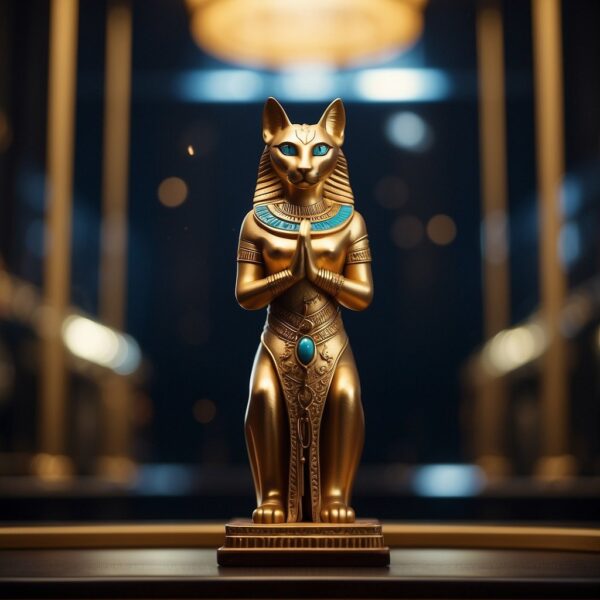
Cat Gods: Exploring catsin Ancient Mythology
The connection between cats and the divine stretches back into antiquity, reflecting the profound impact these creatures have had on human societies. In various ancient cultures, cats were revered and often attributed with spiritual significance, sometimes even worshipped as cat gods. Consider the ancient Egyptians who elevated the cat to a cat deities status, venerating it through the goddess Bastet—she who embodies protection, pleasure, and fertility. Her influence was so pervasive that cats became sacred symbols, believed to harbor divine spirits within them.
Beyond Egypt, other cultures also recognized feline deities or associated cats with divine aspects. These cat gods were not mere idols of domesticity; they symbolized deeper cultural values such as fertility, motherhood, and the duality of nature. Moreover, in some traditions, the representation of a goddess transformed into an actual cat form, indicating an intimate and dynamic relationship between humans and these revered animals. This interchange of divinity and feline form is further reflected in iconography and temples dedicated to cat deities, suggesting that for many ancient civilizations, cats held a significant place in both the mundane and the mystical.
Key Takeaways
- Cats were often revered as divine entities in various ancient cultures, including Egypt.
- Feline deities represent complex cultural values, including protection and fertility.
- Worship of cat deities is highlighted through dedicated temples and iconic symbolism.
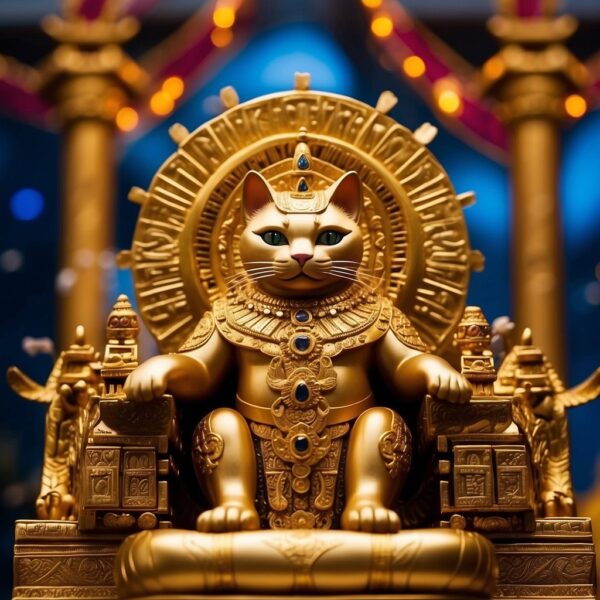
Historical Significance of Feline Gods
Feline deities have played a crucial role across various ancient cultures, symbolizing concepts such as protection, justice, and fertility. They were often integrated into the societal and religious fabric of these civilizations.
Cats in Ancient Religions
In Ancient Egypt, cats were revered and sometimes worshipped due to their association with divine aspects. The water along the Nile was life-giving, and cats, as natural hunters of vermin, were pivotal in protecting granaries, thus safeguarding the essential food supply. Bastet, the feline goddess, symbolized both the home as a nurturing environment and the fierceness of a lioness, embodying the concepts of fertility, domesticity, and war.
Feline Deities and Society
Feline deities were deeply engrained in the culture and daily life of ancient societies. In Egyptian society, cats were a symbol of royalty and protection. They were closely linked with the Theban triad and Heliopolis, where prominent divine felines like Sekhmet represented the destructive power of the sun, whereas Bastet represented its life-giving warmth.
Feline Symbolism in Culture
In various cultures, divine felines were symbolic of justice and power. They appeared in mythology and historical texts, often described as fierce hunters that maintained the balance between good and evil. Their depictions in ancient Egyptian art serve as a testament to their revered status.
Cat Burial Practices
Mummification of cats in ancient Egypt highlights the reverence for these animals. Cat mummies were placed in tombs to provide protection in the underworld, and large cat cemeteries have been unearthed, indicating the scale of their significance.
Artifacts and Depictions
Ancient times saw the creation of numerous objects that featured cats, including statues, bronze figures, and amulets. These artifacts were often carried for protection or used in religious or ceremonial contexts, showcasing the divine connection humans had with cats.
Historical Texts and Myths
Texts from ancient Egypt and other civilizations contain numerous references to cat gods and their myths. From depictions of Sekhmet, the goddess of war and destruction, to the gentle Bastet, these texts offer insights into how feline deities were woven into the fabric of ancient Egyptian mythology.
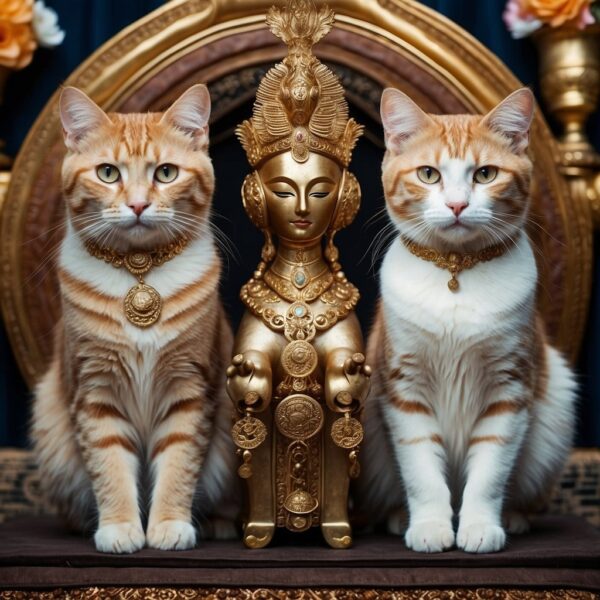
Major cat Gods and Their Roles
Feline deities held significant roles in ancient cultures, particularly in Egypt, where they were revered for their attributes of protection, fertility, war, and justice. These gods and goddesses were often depicted with lion or cat-like features and symbolized the might and grace of their feline counterparts.
Bastet: Protector and War Goddess
Bastet, also known as Bast, served as an Egyptian goddess of protection and was revered for her connection to fertility and motherhood. Originally depicted as a fierce lioness, she evolved into a gentler figure of a domestic cat. She stood as a symbol of the pharaoh’s power, and her protective aspects encompassed both the nation and the home.
Sekhmet: Goddess of Destruction and Healing
The Egyptian goddess Sekhmet, portrayed with a lioness’s head, was a powerful entity associated with both destruction and healing. She was believed to unleash her wrath upon the pharaoh’s enemies, a fearsome warrior and defender of order. Yet, inversely, Sekhmet was also capable of great healing, showcasing the dualistic nature of life and death in Egyptian belief.
Mafdet: Deity of Justice and Execution
Mafdet was one of the earliest Egyptian deities, embodying the principles of justice and execution. Often represented by feline attributes, she was revered as a swift deliverer of judgment and was associated with protection against venomous creatures. Mafdet was linked to the idea of royal and divine justice, ensuring that capital punishment was carried out swiftly.
cat god Maahes: Lion God of War
The deity Maahes, with the fierce features of a lion, epitomized the aspects of war in ancient Egypt. As a lion god, Maahes was connected with the weather and was worshiped in regions such as the city of Thebes. He was considered a devourer of the guilty, aligning with the overarching theme of protection and retribution characteristic of feline gods.
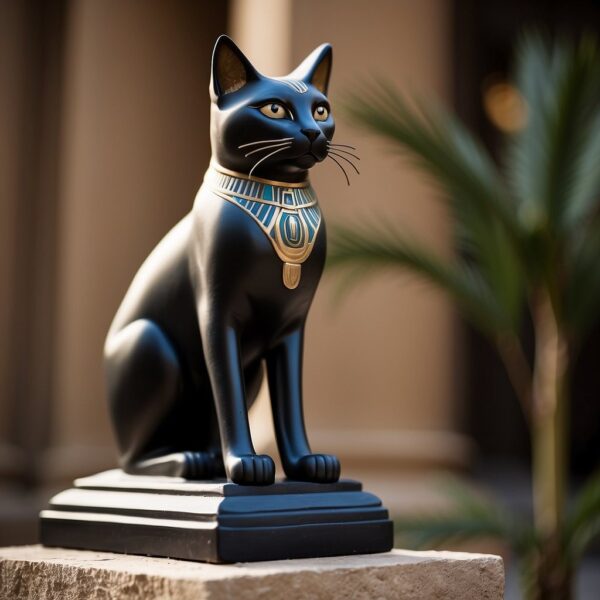
cat Goddesses of Fertility and Motherhood
Ancient cultures revered feline deities, intertwining the symbols of motherhood and fertility with the graceful imagery of domestic cats. Two Egyptian goddesses, Bastet and Mut, exemplify this sacred association within their respective cults.
cat goddess Bastet’s Associations with Fertility
Bastet, the Egyptian goddess, epitomizes fertility and is frequently depicted in the company of cats. She was worshiped in Bubastis, an ancient Egyptian city known for its celebrations in her honor. Her role extended to the protection of mothers and embodying the nurturing aspects of femininity. As a deity, Bastet was not just a guardian of domesticated cats but also a symbol of the home and family. The Egyptians held cats in high regard for their reproductive abilities, which mirrored the fertile landscapes along the Nile and the cultural emphasis on procreation.
Egyptians believed that Bastet could bring both physical and spiritual nourishment, viewing her as a sustainer of life through her ties to moisture and fertility. They celebrated her dual nature of nurturing mother and fierce protector, often invoking her name during rites of fertility and childbirth.
Mut: Cat goddess of Divine Motherhood
Mut, in contrast, was considered the mother of mothers—the queen of all goddesses. She exemplified motherhood and was venerated as the royal mother, with her worship primarily centered in Thebes. Her very name, translated as “mother,” reflects her significant role. Mut was often portrayed as a woman with a vulture headdress, symbolizing her protective and nurturing nature. She was closely associated with both royalty and the divine aspects of mothering.
As a maternal figure, Mut oversaw all matters related to birth and the care of children. Her followers would pray to her for blessings of fertility and the safekeeping of their offspring. Her identity merged with that of other goddesses over time, emphasizing the universal qualities of divine motherhood and the interconnectedness of life’s generative forces.
In essence, both Bastet and Mut stood as towering figures in Egyptian religion, representing critical dimensions of fertility and motherhood. Their cults played essential roles in the fabric of Egyptian culture, with temples, rituals, and a vast pantheon of myths reflecting their profound influence on society’s values and daily life.
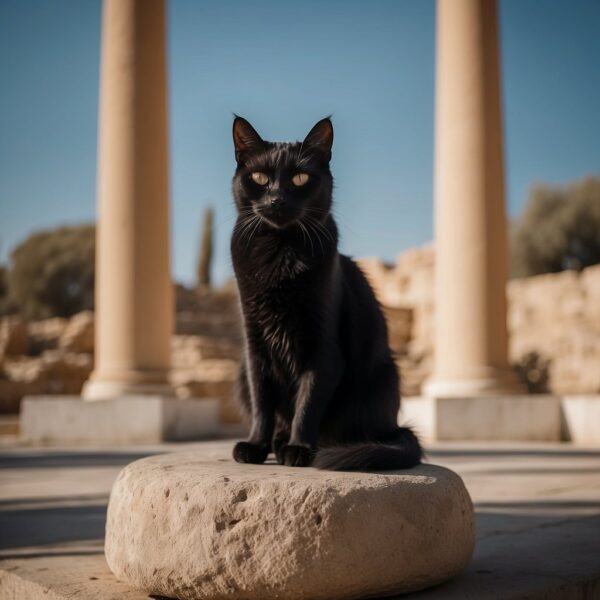
Cults and Temples Devoted to Cat Deities
In ancient cultures, especially in Egypt, the reverence for cats was not only widespread but also deeply institutionalized within religious practices. Temples dedicated to cat goddesses exemplified this adoration, turning felines into symbols of divinity and veneration.
Bastet, the most renowned cat goddess, exemplified protection and was often depicted as a lioness or as a woman with a feline head. The city of Bubastis became the epicenter for her worship, where scores of devotees gathered. The grandeur of her temple, described in Herodotus’ records, underscores the significance placed on these divine felines. Her cult facilitated the mummification of cats, seen as a direct means to honor her.
- Temple of Mut: At Karnak, Mut was worshipped, sometimes associated with felines. As part of her following, cats were regarded as sacred, with some archaeological finds suggesting particular reverence for these animals within her cult.
- Sekhmet: Representing the fiercer aspect of feline deities, Sekhmet, lioness goddess of war and healing, had temples where royalty would worship and seek her mighty protection. The presence of cat statues in these sites reinforced their divine status as both protectors and symbols of power.
The integration of cats in daily and religious life was profound. As protectors of the home and the granary by keeping pests at bay, their utility transformed into divinity. Their images in the form of statuettes, murals, and sculptures permeated temples, conveying the respect for these animals, which transcended the boundaries of the physical world into the spiritual. The domestic feline was not just a pet but a bridge to the divine, etching its way profoundly into the fabric of ancient culture.
Iconography and Symbolism in Egyptian Mythology
In ancient Egypt, cats were venerated and symbolized divine attributes in various forms, often linked to deities like Bastet. Representations in art and artifacts reveal the cultural significance of these feline figures.
Representation in Sculpture and Jewelry
Sculptures from ancient Egypt frequently depict Bastet, the cat goddess, incorporating feline features to signify her divine nature. Statues often portray her as a lioness or as a woman with the head of a lion or a domestic cat, embodying mythology‘s protective and nurturing aspects. These sculptures served not just as religious idols but also as vessels for the spiritual presence of the gods.
Jewelry from this era, such as amulets, often featured cats and were worn for protection. They were carved delicately to denote the wearer’s reverence for Bastet and belief in her protective powers, especially in the context of hunting. These items were not mere adornments but held significant spiritual importance, symbolizing the wearer’s connection to the divine feline.
Divine Felines Through Art and Textiles
Art and textiles from ancient Egypt are replete with depictions of cats. The Brooklyn Museum houses artifacts showcasing the sophisticated weaving techniques of the time, which often included imagery of divine felines. Fabric designs and wall paintings illustrate domestic cats engaging in daily activities, highlighting their ubiquity and cultural significance.
Moreover, cats in artworks were shown partaking in activities connected to hunting, a behavior venerated in Egyptian culture due to its association with provision and sustenance. The representation of cats in these mediums was not merely decorative; it reflected the Egyptians’ deep appreciation for the natural world’s balance and their belief in divine connections with animals.
Comparative Mythology: cat Deities Across Cultures
Throughout ancient cultures, feline deities have been revered for their mystique and prowess. These gods and spirits played significant roles within their respective mythologies, symbolizing everything from protection and fertility to war and the underworld.
cat Gods in Ancient Greece and Rome
In Greek mythology, no feline gods were central to the pantheon, however, lions were associated with several deities such as Hera, symbolizing royalty and power. The Romans, contrarily, did not have a direct feline god but revered feline creatures in the art and armor that characterized their gladiators, associating these animals with strength and martial prowess.
Feline Deities in Asian Traditions
China honors Li Shou as the feline deity responsible for pest control and fertility within the Chinese culture. Statues and depictions of Li Shou are common in ancient texts, illustrating the reverence for cats that existed within Chinese society. Felines were seen as protectors against evil spirits in homes and public spaces.
Native American Feline Spirits
In the traditions of the Ojibwa people, Mishipeshu is a notable water-dwelling panther-like being. Mishipeshu, which translates to ‘Great Lynx’, is often associated with the power of water and rapids, indicating a deep respect for the natural elements and their potential dangers.
Feline-Related Folklore in Slavic and Norse Myth
Slavic folklore references Ovinnik, a spirit in the shape of a large, black cat, believed to protect grains and ensure a good harvest. In Norse mythology, cats are prominently associated with the goddess Freyja, who is drawn in a chariot by two large felines. Cats in this context symbolize a duality of nurturing fertility and fierce warfare.

Frequently Asked Questions about cat gods
Feline deities appear across various mythologies, embodying protection, fertility, and sometimes, war. These ancient cultures held cats in high regard, often attributing divine qualities to them.
Who are some notable female deities associated with cats in mythology?
In ancient Egypt, the goddess Bastet is renowned as the cat goddess, symbolizing protection and fertility. This deity often took the form of a lioness or a woman with the head of a lioness or domestic cat.
What is the role of feline deities in Norse mythology?
Norse mythology does not prominently feature cats as deities, but the goddess Freyja’s chariot being pulled by cats is a vivid display of their spiritual significance, depicting these creatures as sacred and powerful.
Which Roman deity is most closely associated with cats?
Diana, the Roman goddess of the hunt, wild animals, and the moon, is the deity most closely linked with cats in Roman culture. Cats were revered for their hunting prowess, paralleling Diana’s attributes.
Can you identify any indigenous cultures that revered cat gods or spirits?
In the Americas, many indigenous cultures revered feline figures. For instance, the jaguar was seen as a powerful totemic animal in the mythologies of South and Central American cultures, symbolizing authority and fertility.
How is Bastet significant in Egyptian mythology as a cat goddess?
Bastet, initially depicted as a lioness in Egyptian mythology, evolved to be represented as a more domesticated cat later on. She is significant for her dual nature of nurturing home and family while also protecting them as a fierce warrior when necessary.
What are some male deities linked to cats in ancient mythologies?
In Egyptian mythology, the sun god Ra was symbolized by a male cat, representing the solar aspect and the cyclical nature of the sun. Additionally, in various cultures, male feline deities sometimes embodied traits of strength, agility, and dominance.